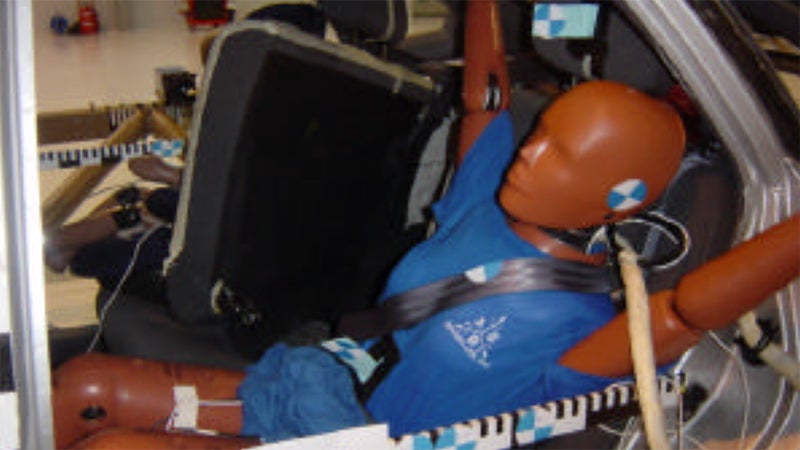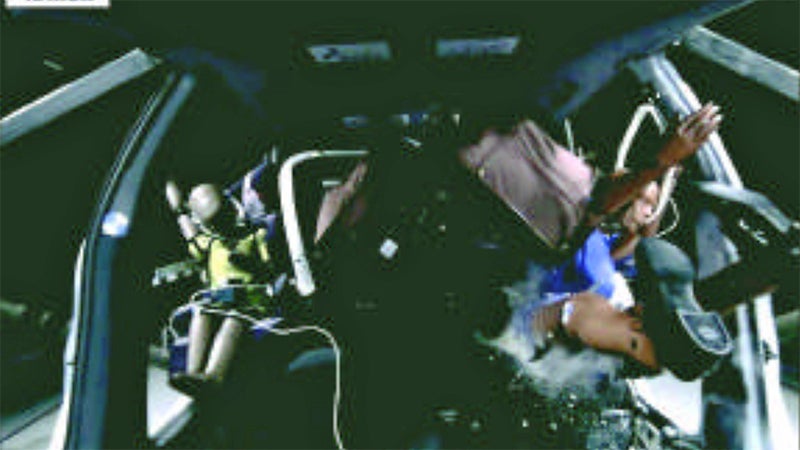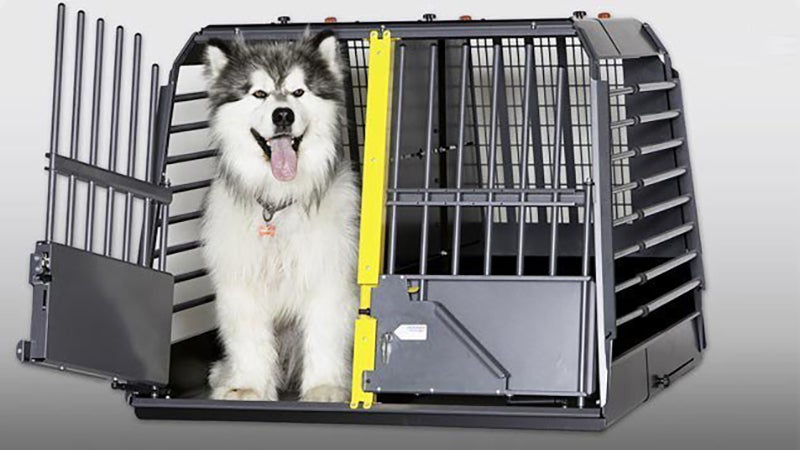The seats in your car probably aren’t as strong as you think. And if you own a large dog,��those seats will��not be able to restrain them in a crash. Fortunately,��I found a solution.
The Problem
In the U.S., the regulation governing the strength of automotive seats is . It requires that the seats in your car��be capable of withstanding a force applied forwards or backwards that’s equivalent to 20 times the weight of the seat itself, but allows for 40 degrees of seat deflection under that strain.��That’s a problem because that��force is static, not dynamic (equivalent to slowly pushing or pulling on the seat really hard), which fails to account for the incredibly rapid acceleration objects inside a vehicle experience��in a crash. It’s also just not strong enough.
Three years ago, I wrote an article about dog safety restraints, explaining how ineffective and problematic most of them are. In it, I identified the main problem all of us dog owners face: in a 35-mile-per-hour crash, an unrestrained 60-pound dog becomes a projectile flying forwards with 2,700 pounds of force. Cars are designed for human, not canine occupants, so restraining a��four-legged projectile is��difficult.
Let’s say a seat weighs 50 pounds. To be sold in��a car in the U.S., it must be capable of standing up to 1,000 pounds of force. Put a 60-pound dog behind it, run into something immovable at 35 mph, and��your pup will generate nearly three times that much force as it flies forward. The seat will not be capable of stopping the dog’s movement, and that could kill it, or any human passengers sitting in front of it.
All of this obviously applies beyond dogs.��If hit from behind, a vehicle’s front seats can fail to restrain humans sitting in them from flying rearwards, injuring and . And simple cargo like luggage or tools��quickly become lethal projectiles. It’s a scandal that pops up ever few years and��is present on��even the latest, otherwise very safe cars. Safety advocates��refer to the construction of car seats as being equivalent to “.”
“FMVSS 207 is just a really old standard,” says George Hetzer III, a former seating engineer for TS Tech Americas, a major automotive seat supplier. “The industry has made significant progress on seat safety in subsequent decades, but without market demand, it’s just not a huge priority.” The standard was .
Hetzer says that in the absence of a modern seat strength standard from the American government, most manufactures now benchmark the slightly more stringent European standard, . But ECE-R17 only mandates a test in which two 34 pound blocks are placed behind, but in contact with the rear seats, and a crash with an accelerative force of 20 to 28g is simulated. All cars decelerate at different rates due to variances in their energy absorbing structures (crumple zones), but those forces are created in crashes of only 20 to 30 mph.��Seats made to the European standard are also incapable of stopping a 60 pound dog traveling at 35 mph.
created by the European Association for the Co-ordination of Consumer Representation in Standardisation says there are��“shortcomings in current legislation” and calls for a more realistic test: four 50-pound suitcases accelerated at rates equivalent to a 30 mph crash. The results, from tests conducted on seats made to the current standard, are illuminating.

“The central seat back hinges released and allowed the luggage to enter the passenger compartment where it could threaten the front seat occupants, as well as those in the rear,” says��the paper. It’s written in very dry engineering language, but the report’s assessment of the impact of that flying luggage on the test dummies is clear:��it says the forces they experienced, “leaves the safe plane.”

Personally, I don’t use my vehicles to transport four 50-pound suitcases;��I use them to carry three large dogs, the heaviest of which, Teddy, weighs 115 pounds. In a 35 mph car accident, Teddy would turn into a projectile with a force equivalent to about 5,300 pounds. And, as I identified in that��article on pet restraints, there is no effective way to tether a dog that large inside a vehicle in a way that won’t injure or kill them in a crash.

The Solution
But I love my dogs, so I had to figure this out.��My search led to��MIM, a Swedish range of products built and in crashes of around 30 mph. MIM produces ($1,160 to $2,000) that protect and retain the dog from the front, sides, and rear. That’s a lot of safety, but installing one rules out being able to use a car’s cargo area for purposes beyond transporting dogs. MIM also produces a ($285-$380) tested to the same standard, but it only covers the portion of the car above the height of the rear seats. If a dog impacts the unprotected portion of the seat back, that barrier would do nothing.
I wanted to be able��to occasionally carry normal cargo in the back of my family’s Land Cruiser, and maybe to even store essentials back there in some organized fashion. I was familiar with Australian 4×4 accessory maker ARB’s range of storage drawers and cargo barriers from my time crossing the Simpson Desert in vintage off-roaders, but the drawers were too tall to leave enough room for my big dogs. And the matching cargo barriers only work in combination with the drawers. Frustrated, I complained to the company. My timing on that was right, because a representative responded with good news: they were just about to release a new, lower height system targeted at dog owners.
Installed, ($1,500) still allows for storage space that measures inside the drawers—enough for a large recovery strap��or an automotive fire extinguisher lying on its side. Side panels box out the wheel arches to square off the main cargo area, and provide some storage for bulkier items, like heavy-duty bottle jacks. The best part, though, is that the total height of the drawer portion is just 7.5 inches. Barely any space for dogs is lost.
The drawers bolt to the vehicle’s frame rails, underneath the floor of the rear cargo compartment. And ($730) attaches at the same points on the bottom, then replaces the rear grab handles with ��that allows some controlled movement of the barrier, slowing a dog’s deceleration rate on impact.��The barrier is built to Australia and New Zealand’s , meaning it’s been tested to withstand the��impact of a��120 pound object��in a 30 mph crash, and that it remains compliant with the rear curtain airbags of the vehicle it’s designed for. It completely encloses the rear cargo area, from the top of the drawers��to the ceiling, which also means it’ll be backed up by whatever strength the seats are able to add. The barrier��is designed for easy removal without tools, and stores behind the front seats—convenient should we need to fold the second row to transport a large object.
ARB’s drawer systems and cargo barriers are available across multiple vehicle platforms. Consult to find out if they make systems that fit yours.��Because the barrier shares the points where the drawer system bolts to the frame, it’s only available with those drawers.
Do you need to spend thousands of dollars on a barrier to keep your dogs safe?��If you have a small or medium-size dog, the answer is likely no. ��($80) remains the best way to secure those animals inside your car. But, if you have a large dog, then safety needs to be a real priority. You paid a lot more than $2,200 to make sure you’re driving a safe, modern car. Failing to account for the presence of your dog in that vehicle undermines every seatbelt, airbag, and crumple zone you just rolled into a monthly payment.
The European Association for the Co-ordination of Consumer Representation in Standardisation has for anyone carrying anything in the back of their vehicle. During testing, they found that latching all available seatbelts across empty seats added a considerable (but undefined) amount of load resistance. So��you should keep all your seatbelts buckled anytime a seat is unoccupied. It also noted that the amount of force a seat could tolerate near its base was greater than near its headrest, since seats typically pivot around a point near their bottom. Carrying loads as low as possible, and up against the seat back to prevent acceleration is an effective safety strategy. The association also recommends tying down any loads. Many of the tips are impossible for large dogs, but are good advice for smaller animals.
If nothing else, this is a good reminder to drive safely. We all probably drive faster than the rated limits of the safety equipment in our vehicles every day.


